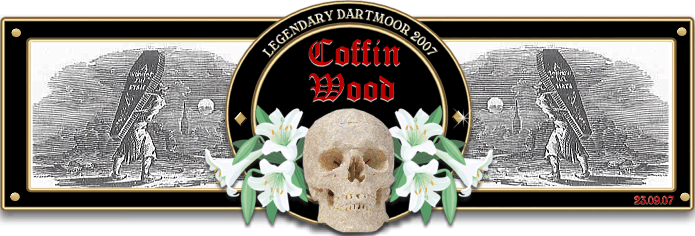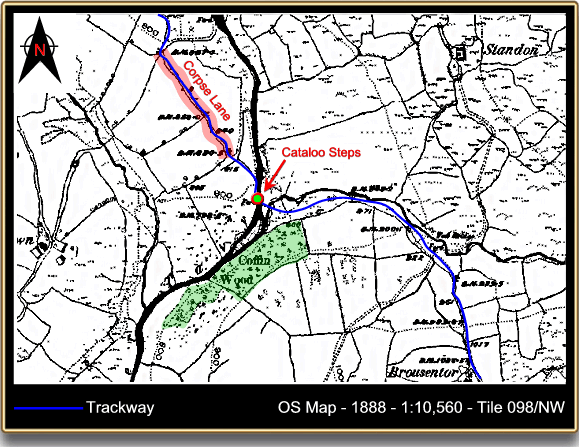
“Now it is that time of night,
That the graves all gaping wide,
Every one lets forth his sprite,
In the church-way paths to glide“.
Shakespeare – A Midsummer Night’s Dream
Sometimes one can look at a map and see a place-name and wonder what on earth went on in order for the place to get such a name – Coffin Wood is one such place. The story gets even more interesting when a larger section of the landscape is considered, in this case a small lane close to Coffin Wood is called Corpse Lane. Both names are suggestive of death and local folklore points to such a connection, there are stories of strange flickering lights being seen floating through Coffin Wood on dark, wild nights, suggestive of Jack O’ Lanterns. Normally this phenomenon is associated with mires and marsh gas so why are have they been reported in woods? The answer lies in the map below and the blue winding track which weaves its way past Coffin Wood, over the Tavy and on up through Corpse Lane, this a a part-section of the Lych Way. In medieval times it was along this track that the folks from the central moor would carry their dead for burial at Lydford church.

Ok, so we have the ‘Way of the Dead’ going past Coffin Wood and up Corpse Lane – QED, well not quite, firstly why was the wood so called? Was this where the wood to make coffins was taken from? Up until Coffin Wood the majority of the journey to Lydford would have involved crossing exposed, open moorland and therefore it would have been difficult to carry a corpse in a wooden coffin. So, it is thought that the body would be carried wrapped in a shroud and when the funeral party reached Coffin Wood they would transfer the deceased into a coffin, hence the name. No doubt the shelter of the trees also made an ideal spot for people to have a rest and possibly some refreshments after their long arduous moorland trek. The remainder of the route led across ground that was a lot easier to traverse with a heavy load such as a body in a coffin.
For centuries people walked the various tracks that led from remote areas to their nominated churches which can be categorised by the term’ Church Way’. However, as noted above it was not only the living would went along these trackways it was also their dead and so the tracks in some cases became known as ‘Corpse Roads‘, ‘Bier Roads’, Coffin Lines’ or as in this particular case – Lych Ways. The very word lych is a corruption of the old Anglo Saxon word, lichama meaning ‘corpse or body’ or alternatively the tracks were known as deada wæg. Today many of these old trackways have either disappeared or have been sensationally made into walks as is the case of the modern re-routed Lych Way. I suppose in some way they help support the economies of many areas as walkers who tread their ancient paths do spend money whilst in the area. Indeed, Dartmoor’s Lych Way is host to an annual walk held by the Dartmoor Rescue Group in order to help raise much needed funding. At one time a similar walk was held during the night, the darkness adding an ‘interest’ factor to walking the way of the dead. But it could be argued that 800 years ago these corpse roads were held in a very different light as the words of puck in the quotation above show. There seemed to be this deep rooted belief that once a corpse road had become established it also acted as a kind of dual carriageway, one lane was the geographical track which was embedded in the landscape and the other lane was an unseen, virtual path used by spirits from the otherworld. In Germany these virtual paths are known as Leichenflugbahns which literally means – corpse flightpaths. Another concept of the virtual spirit paths was that they always ran in a straight line which followed their physical paths as closely as possible. If you look at the Lych Way much of its moorland course is a fairly straight one within the constraints of the terrain. At one point near Powder Mills the original route ran straight through a mire when it would have been quite possible to make a slight and much drier detour. In Medieval times the greatest fear which lay in the hearts of the moorfolk was that the spirits of their departed would return back down the spirit paths to haunt the living. In light of this there were a few superstitions that were followed when taking the dead along the corpse roads, the commonest thing was to carry the body with the feet pointing away from its one-time home. Another adherence was to carry the body over as many bridges or stepping stones as possible because spirits couldn’t cross open streams or rivers. Is it a coincidence then that the Lych Way crosses at least seven major streams or rivers from Bellever to Lydford?
Mike Brown notes another tradition regarding corpse roads, although unsubstantiated there is the belief that once a corpse has been carried down a route that leads to a church it then becomes a public right of way. He considers that this practice was common by the mid 1400s as a documented dispute of 1488 illustrates.
 Legendary Dartmoor The many aspects past and present of Dartmoor
Legendary Dartmoor The many aspects past and present of Dartmoor
